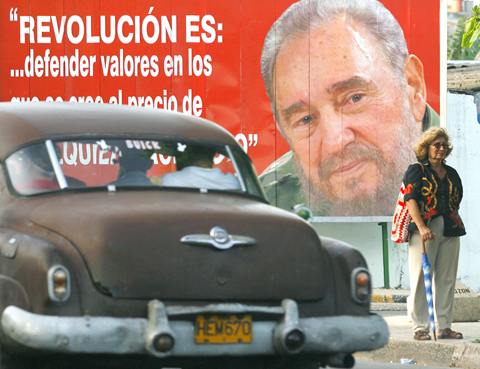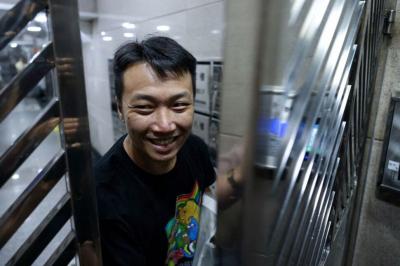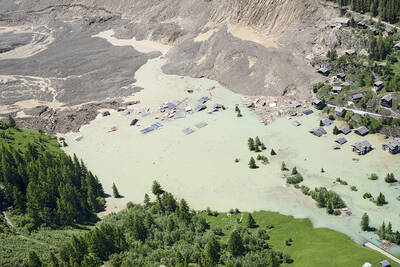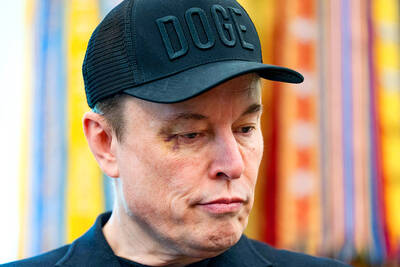Eleven-year-old Olga enters the beach house in flip-flops, her hair still wet from a dip in the Caribbean.
“I really like it here,” she says. “The food is great, the beach is awesome. I made some fantastic friends.”
A typical child’s reaction to a beach holiday, perhaps — only this is no ordinary seaside break. Olga is a Ukrainian “Chernobyl child,” in Cuba not for a holiday but to undergo intensive medical treatment with some of the country’s best doctors.

PHOTO: REUTERS
She goes to school here along with 180 other Ukrainian children.
“I miss some bits of my home town,” she said. “But I don’t ever want to leave.”
Olga is one of more than 18,000 Ukrainian children to have been treated over the years at the Tarara facility near the Cuban capital, Havana. The program was set up in 1990 to treat the victims of the world’s most devastating nuclear accident four years earlier.
Twenty-three years after Chernobyl, the Cuban program is still going strong. Remarkably, children born years after the disaster still suffer physical consequences of the meltdown that irradiated large parts of Ukraine and Belarus; equally remarkably, despite isolation and economic miasma, Cuba still manages to tend to them.
Olga’s freckled face is marbled with pink and brown patches because of depigmentation. Her arms and legs are also affected. She suffers from vitiligo, a skin disease that some believe is caused by a combination of genetic and environmental factors. Both those causes can be attributed to her case: She was born in a small village in northern Rivne Province in Ukraine, near Chernobyl.
The cost of Chernobyl will be met over decades and over generations. There will never be an exact figure of the victims of the catastrophe. For many, the impact is not in their past, but in their future. The damage is not only physical, said Maria Teresa Oliva, a paediatrician and deputy director of the program.
“[The children] are very much affected by not only medical ailments but also by the psychological effects of their environment and their dissease, so they require permanent special care,” she said.
In Tarara, the children get treatment based on the seriousness of their illness: sometimes 45 days, sometimes six months — in Olga’s case a whole year. Next to her 13-year-old Marina from Kiev is half bald, but slowly recovering her hair. She arrived in March for a third visit to be treated for alopecia.
“I love coming here,” she says. “I feel much better since I started coming to Cuba. For me there is really no reason to miss Ukraine. The doctors, the teachers, everybody is great.”
While some disorders — such as the 30-fold increase in thyroid cancer among Ukrainian children — are directly linked to the Chernobyl accident, it is not known whether some of the other pathologies are caused by radioactive pollution or post-traumatic stress disorder.
“But there is a nexus,” Oliva said.
Ukrainian authorities have expressed their gratitude to Cuba on several occasions. But though it forms part of Cuba’s international revolutionary public relations, the difference between this program and others — such as the exchange of Cuban medical expertise for Venezuelan oil — is that there is no economic gain. The program even survived Cuba’s economic crisis of the early 1990s, the so-called “special period” after the fall of the Soviet bloc.
Austerity is still apparent across the island, but the Chernobyl project has survived thanks to an agreement between the two countries: Ukraine covers transportation, while room, board, schooling and medical services are covered by Cuba. Some unofficial estimates put Cuba’s expenditure at more than US$300 million in medical costs alone.
“Many people who are unaware of our ideals still wonder what Cuba might be after,” Julio Medina, general coordinator of the program, recently told the Cuban newspaper Granma. “It is simple: We do not give what we have in excess; we share all that we have.”

Four people jailed in the landmark Hong Kong national security trial of "47 democrats" accused of conspiracy to commit subversion were freed today after more than four years behind bars, the second group to be released in a month. Among those freed was long-time political and LGBTQ activist Jimmy Sham (岑子杰), who also led one of Hong Kong’s largest pro-democracy groups, the Civil Human Rights Front, which disbanded in 2021. "Let me spend some time with my family," Sham said after arriving at his home in the Kowloon district of Jordan. "I don’t know how to plan ahead because, to me, it feels

Poland is set to hold a presidential runoff election today between two candidates offering starkly different visions for the country’s future. The winner would succeed Polish President Andrzej Duda, a conservative who is finishing his second and final term. The outcome would determine whether Poland embraces a nationalist populist trajectory or pivots more fully toward liberal, pro-European policies. An exit poll by Ipsos would be released when polls close today at 9pm local time, with a margin of error of plus or minus 2 percentage points. Final results are expected tomorrow. Whoever wins can be expected to either help or hinder the

The collapse of the Swiss Birch glacier serves as a chilling warning of the escalating dangers faced by communities worldwide living under the shadow of fragile ice, particularly in Asia, experts said. Footage of the collapse on Wednesday showed a huge cloud of ice and rubble hurtling down the mountainside into the hamlet of Blatten. Swiss Development Cooperation disaster risk reduction adviser Ali Neumann said that while the role of climate change in the case of Blatten “still needs to be investigated,” the wider impacts were clear on the cryosphere — the part of the world covered by frozen water. “Climate change and

DENIAL: Musk said that the ‘New York Times was lying their ass off,’ after it reported he used so much drugs that he developed bladder problems Elon Musk on Saturday denied a report that he used ketamine and other drugs extensively last year on the US presidential campaign trail. The New York Times on Friday reported that the billionaire adviser to US President Donald Trump used so much ketamine, a powerful anesthetic, that he developed bladder problems. The newspaper said the world’s richest person also took ecstasy and mushrooms, and traveled with a pill box last year, adding that it was not known whether Musk also took drugs while heading the so-called US Department of Government Efficiency (DOGE) after Trump took power in January. In a